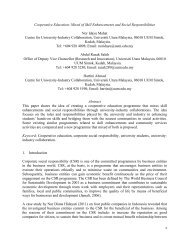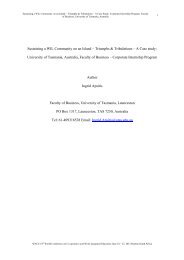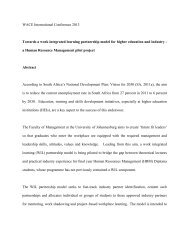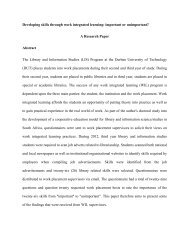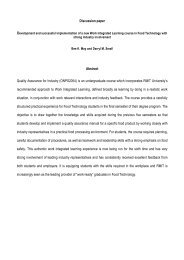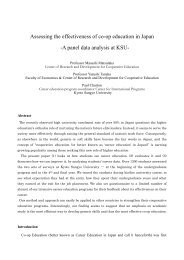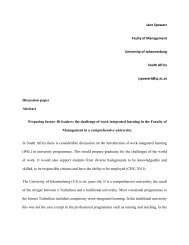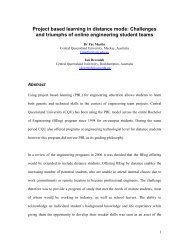Kate Andre, Bev Ewens & Fiona Foxall, Edith Cowan ... - WACE
Kate Andre, Bev Ewens & Fiona Foxall, Edith Cowan ... - WACE
Kate Andre, Bev Ewens & Fiona Foxall, Edith Cowan ... - WACE
- No tags were found...
You also want an ePaper? Increase the reach of your titles
YUMPU automatically turns print PDFs into web optimized ePapers that Google loves.
ability to develop and enhance skills is more appropriate in the current work environment andunderpins the interpersonal skills development which result in changes to practice [18, 19, 20,21, 22].Lester [23] argues that there is considerable scope for development of University WILprograms and hence should be viewed as mainstream activity. Traditional WIL curricula (e.g.theoreticum to prepare for practice) have focused on the prescription of learning outcomesdictated by education and/or industry staff based on the professional WIL model, the servicelearning model or the cooperative learning model [24, 25, 26]; however, to meet the needs ofECU postgraduate nursing students, clinical partners and their client groups, an innovativeWIL program of study needed to be conceptualised. Following an extensive literature reviewon WIL programs worldwide, the WIL model created by Middlesex University in the UnitedKingdom, (which loosely reflects the cooperative learning model), informed the initialdevelopment of the ECU WIL model.The ECU WIL curriculum promises to have particular merit in the context of theWestern Australian higher education sector. Firstly, the Western Australian nursing highereducation market is highly competitive, where students are primarily self-funded and timepoor. Therefore, delivery of the ECU WIL Master of Healthcare Studies degree program ismarketable based on its ability to meet the needs of Western Australian postgraduate nursingstudents while affording tangible benefits to industry partners and further strengtheningECU’s relationship and engagement with these organisations. Importantly, where pastpostgraduate nursing curricula were confined and potentially limited professional growth, thepotential of the new ECU WIL program is dynamic and with the promise of longevity andsustainability due to its ability to address and meet the challenges for education of thecontinuously evolving health practitioner. The range of benefits for each of the ECU WILparties are summarised as:
teaching models due to the expense of specialist staff and clinical learning resources. In orderto maximize the efficiencies of ECU SNM’s postgraduate course offerings, it was decided toconsider the potential of a novel WIL curriculum centred on the student’s nursing ormidwifery practice, rather than a traditional didactic program in which the University dictatesthe confines of learning. In order to achieve this, it was important that the student be centralto the learning process and take the responsibility for a trilateral agreement between thestudent, University and industry employer. It was conceptualised that as part of thisagreement, the student co-ordinates meetings and agreements with their ‘Project ManagementTeam’ which consists of an industry personal tutor, ECU course coordinator and othernominated persons. Students are allocated to their personal tutors based on their clinical andeducational need and are required to manage this relationship as part of the development andimplementation of their WIL program. Within the scope of the ECU WIL Master’s degree,each student designs their learning outcomes, learning methodology and assessment strategyfor all WIL units. At this stage, the University equips the students with the necessary tools toenable them to plan their program, critically conceptualise and analyse practice throughcompletion of an initial planning and role development unit. In this unit, the student reflectson their current role, determines their learning goals and develops a learning plan that enablesachievement of their learning goals. Students also study a proportion of taught units whichresult in a coherent pathway of study, where chosen elective units provide impetus forachievement of the contracted student learning goals. This enables appropriate, meaningfuland applicable learning to take place within the student’s specific area of practice and thusprovides a program of study which is valuable to both clinicians and educators [10]. Thedefinition of WIL in the context of the ECU model thus became “to work in a dynamicpractice situation in which an experienced practitioner develops their own role while meeting
Figure 1. The ECU WIL Model.the strategic outcomes of the affiliated organisation and gaining academic credit for theirlearning”.The ECU WIL modelThe central spiral of the ECU WIL curriculum is the productive trilateral relationshipbetween the student, University and industry (Fig. 1). The achievement of this relationship isevident through the products of student learning that address industry priorities and thecourse learning outcomes. The outer circles represent the enabling factors necessary tosupport the success of the student and the program, which in turn reflect the health care needsof the future. All WIL parties are in some way responsible for the achievement of theenabling factors; for instance, both the University and industry need to provide a suitablelearning environment to enable the student to achieve these generic skills. Within theprogram structure, the student is required to reflect upon their plans and achievements toensure that they meet the essential enabling skills such as scoping, critical reflection, projectmanagement, problem solving, evaluation of research and dissemination of new evidencethrough communication of outcomes.
The program planning is of paramount importance to this award, as it underpins the wholeprogram of learning and ensures issues such as quality, academic standards and expectationsof postgraduate students are addressed. The aims and outcomes of the award will ensure thatstudent’s learning is intrinsically linked to their work area. Students will be expected tojustify their WIL assessment choices to their employer, personal tutor and course coordinator,who ensure, in conjunction with the assessment board, that a coherent study pathway isplanned and followed. A range of mechanisms are being devised to support students in theachievement of overall course learning outcomes, including the development of a courseportfolio as well as local and extended learning communities.As identified by <strong>Andre</strong> and Heartfield [29] a well developed portfolio is a usefulapproach to enable professionals to demonstrate and reflect upon their practice in a mannerthat supports individuals to predict, respond to and potentially influence professional andindustry outcomes. The relationship between portfolios, self regulation and professionalmobility is an imperative for students to become familiarised with the skills of selfassessmentand development of quality evidence of performance outcomes, competence andcapacity. The educational benefits of portfolios and learning communities to supportcollaborative and authentic learning are well understood [30,31,32]. It is a developmentpriority of this program that the student be provided with a structured program, includingassessment incentives, to support a sustained uptake of these initiatives. A further portfoliorequirement is that the student assembles evidence to frame an argument of theirachievements. Learning materials are currently under development at ECU to enable studentsto understand and accumulate quality portfolio evidence through the determination of qualityevidence of performance, peer review, bench marking and authentication where the finalportfolio associated with their learning course becomes a portfolio defence. As the courseprogresses, each student will have mapped their project activities across a matrix of depicted
course learning outcomes where the objective of the map is to ensure that the studentdemonstrate their full range of learning outcomes. At regular Project Team Managementmeetings, students will have justified how current and future project activities attend to thebreadth of their learning outcomes when at the final portfolio defence, the student provides anoverview of the means by which they have met their final learning outcomes. Within thisdefence, the student is required to articulate their generic achievements, provide supportingevidence and apply scoping and reflective approaches to explain their future career and/orproject intentions.Students in the ECU WIL course will also be given access to a course blog wherestudents across the course will be encouraged to problem solve online, access other forms ofprofessional social media to exchange ideas and use social media opportunities in aprofessional collaborative manner. The development and use of communities of practice hasbeen long identified as valuable to engage students in collaborative learning and socialaction[33]. While ambitious, the course developers have identified the need to resource theinclusion of materials and incentives to support an online community of practice specificallyfor this course. It is anticipated that this form of collective learning will result in individualsand groups of students becoming more proactive and pursue enterprises in a manner theywere unlikely to do in isolation from these online communities of practice.ConclusionIn conclusion, the ECU WIL Master of Healthcare Studies curriculum has beenconceptualised and developed with an aim to provide students with the opportunity to gain apostgraduate qualification through learning in the workplace. The program also aims toprovide a flexible learning environment where the needs of both the student and employer arecentral to the development of the program of learning while continuing to focus on workplace
issues, protocols, policies and procedures, which promote direct benefits for both student andemployer during the program of study. The program is primarliy student focused and enablesindividual negotiation and development of learning outcomes for their award. This ensuresthat each student undertakes a unique program of study and provides individualisation oflearning to meet employers’ strategic objectives and health improvement agendas. Thecourse-based community practice blog, associated utilisation of social media to achieveprofessional outcomes and student portfolio are further examples of this innovative studentcentred approach to curricula design that will provide valuable career planning and positionapplication resources. The program provides both accessibility and flexibility in educationprovision and is responsive to the diverse requirements in the vast geographical area ofWestern Australia.References[1] K. <strong>Andre</strong>, E-Portfolios for the aspiring professional Collegian: Journal of the RoyalCollege of Nursing Australia 17 (2010) 119-124.[2] P. Fulbrook, J. Cockerell, Education for outreach: development of an interprofessionalMS in critical care, Nursing in Critical Care 10 (2005) 255-262.[3] L. Chapman, E. Howkins, Work-based learning: making a difference in practice, NursingStandard 17 (2003) 39-42.[4] G. Rhodes, G. Shiel, Meeting the needs of the workplace and the learner through workbasedlearning, Journal of Workplace Learning 19 (2007) 173-187.[5] L. Dyson, B. Hedgecock, S. Tomkins, G. Cooke, Learning needs assessment forregistered nurses in two large acute care hospitals in Urban New Zealand, NurseEducation Today 29 (2009) 821-828.[6] R. Fryer, Learning for a Change in Healthcare, Department of Health, London, 2006.[7] D. Kemp, , Higher Education report for the 2001 – 2003 Triennium., Canberra, 2001.[8] I. Nixon, K. Smith, R. Stafford, S. Camm, Work-based learning:Illuminating the highereducation landscape., The Higher Education Academy Heslington, York UK, 2006.[9] K. Manley, A. Titchen, S. Hardy, Work-based learning in the context of contemporaryhealth care education and practice: A concept analysis, Practice Development inHealth Care 8 (2009) 87-127.[10] F. <strong>Foxall</strong>, M. Tanner, Work based learning: Quantifying enhancements to healthcarepractice., University of Wolverhampton UK, UK, 2008.[11] J. Lave, E. Wenger, Legitimate peripheral participation in communities of practice, in:R. Harrison, F. Reeve, A. Hanson, J. Clarke (Eds.), Supporting lifelong learning:Perspectives on learning., Open University Press., London, 1991.[12] M. Eraut, J. Alderton, G. Cole, P. Senker, The impact of the manager on learning in theworkplace. , in: F. Reeve, M. Cartwright, R. Edwards (Eds.), Supporting lifelonglearning: Organizing learning. , Open University Press, London, 1999, pp. pp91-108.
[13] M. Eraut, Apprenticeship as a mode of learning., Learning in Health and Social Care 2(2003) 117-122.[14] M. Eraut, Editorial: The practice of reflection., Learning in Health and Social Care 3(2004) 47-52.[15] M. Eraut, Informal learning in the workplace, Studies in Continuing Education 26(2004b) 247-273.[16] L. Chapman, Improving patient care through work-based learning., Nursing Standard 20(2006) 41-45.[17] A. Felstead, A. Fuller, L. Unwin, D. Ashton, P. Butler, T. Lee, Surveying the scene:learning metaphors, survey design and the workplace context, Journal of Educationand Work 18 (2005) 359-383.[18] L. Hamilton, 'Implicit Theories of Ability: teacher constructs and classroomconsequences', Scottish Educational Review 38 (2006) 201-212.[19] M. Eraut, Continuity of learning. , Learning in Health and Social Care 4 (2005) 1-6.[20] S. Leitch, Review of skills: Prosperity for all in the global economy - world class skills.,HMSO, London, 2006.[21] J. Yielder, An intergrated model of professional expertise and its implications for highereducation., International Journal of Lifelong Education 23 (2004) 60-80.[22] J. Bridger, From passive to active learners: The “lived experience” of nurses in aspecialist nephrology nursing education program, Journal of Workplace Learning 19(2007) 78-91.[23] S. Lester, Professional practice projects: APEL or development?, Journal of WorkplaceLearning 19 (2007) 188-202.[24] L. Cooper, J. Orrell, M. Bowden, Work Integrated Learning: A guide to effectivepractice. , Taylor and Francis., New York, 2010.[25] R. Bringle, J. Hatcher, Implementing Service Learning in Higher Education, Journal ofHigher Education 67 (1996) 221-239.[26] R.E. Slavin, Cooperative Learning, Review of Educational Research 50 (1980) 315-342.[27] <strong>Edith</strong> <strong>Cowan</strong> University, Engaging Minds, Engaging Communities:Towards 2020, in: S.Plan (Ed.), ECU, Perth, 2012.[28] S. Haper, S. Quaye, Student Engagement in Higher Education, Routledge, New York,2009.[29] K. <strong>Andre</strong>, M. Heartfiled, Nursing and Midwifery Portfolios: evidence of continuingcompetence, Elsevier, Sydney, 2011.[30] J.I.S.C. (JISC), Crossing the Threshold: Moving e-portfolios into the mainstream, 2012.[31] H. McNeill, J.M. Brown, N.J. Shaw, First year specialist trainees’ engagement withreflective practice in the e-portfolio, Advances in Health Sciences Education 15(2010) 547-558.[32] S. Or Kan, Cooperative Learning Environment with the Web 2.0 Tool E-PortfoliosTurkish Online Journal of Distance Education 12 (2011) 201-213.[33] E. Wenger, McDermott, R. and Snyder, W. , Cultivating communities of practice: aguide to managing knowledge, Harvard Business School Press, Cambridge 2002.



